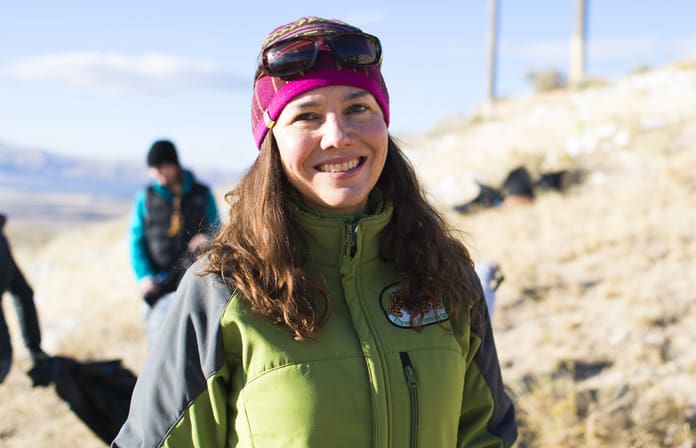
Biography
Wendy Ridenour is an ecologist and Professor of Biology at The University of Montana Western, where she has taught experiential classes full time since 2009. Her current research focuses on whole community dynamics in alpine systems, including plant-plant and plant-herbivore interactions and how alpine communities respond to anthropogenic climate change. Her post-doctoral research in Chile and New Zealand also concentrated on alpine community dynamics. She received her PhD from the University of Montana Missoula in 2006 in Organismal Biology and Ecology.
Ridenour’s dissertation research focused on the question: why do some exotic plant species attain very high densities and dominance in communities to which they are alien but occur at very low densities in their native communities? “Invaders” such as these can be very destructive to native ecosystems and cause extensive economic impacts. Her research on the aggressive North American invader from Europe, spotted knapweed, Centaurea maculosa (C. stoebe) explored the hypothesis that some exotic invasive plants may transform from rare components of their native communities to competitive dominants because of their novel biochemistry (known as the “novel weapons” hypothesis; Callaway and Ridenour 2004). She discovered that these strong biogeographical differences in C. maculosa’s impacts in its native and non-native ranges is largely due to the fact that naïve native North American species of plant competitors and generalist herbivores are more susceptible to the chemical effects of this invader than species native to C. maculosa’s native range. C. maculosa shows evidence of being more competitive and allelopathic to North American native species than species in the native ranges of this invader, and C. maculosa plants in their invasive North American range are much better defended against generalist insect herbivores. Her 2004 publication Novel weapons: invasive success and the evolution of increased competitive ability is one of the 100 most notable papers of the past 100 years, having made a significant impact on the field of ecology (Ecological Society of America).
A portion of Professor Ridenour’s dissertation research also focused on experiential science education, and she currently enjoys teaching field and laboratory based Experience One courses in Alpine Ecology, Botany, Coral Reef Ecology, Introductory Biology courses for majors and non-majors (BIOB 101, 160 & 170) and Plant Systematics as well as conducting research with student interns.
Selected Publications
• Zaal Kikvidze1, Rob W. Brooker, Bradley J. Butterfield, Ragan M.Callaway, Lohengrin A. Cavieres, Bradley J. Cook, Christopher J. Lortie, Richard Michalet, Francisco I. Pugnaire, Sa Xiao, Fabien Anthelme, Robert G. Björk, Brittany H. Cranston, Rosario G. Gavilán, Robert Kanka, Emanuele Lingua, Jean-Paul Maalouf, Jalil Noroozi, Rabindra Parajuli, Gareth K. Phoenix, Anya Reid, Wendy M. Ridenour, Christian Rixen & Christian Schöb. 2015. The effects of foundation species on community assembly: a global study on alpine cushion plant communities. Ecology 96(8):2064-2069.
• Ridenour, W.M., R.M. Callaway & L.A. Cavieres. 2014. Parasitism by Cuscuta chilensis and gender affect how the nurse cushion Laretia acaulis increases diversity in Andean alpine communities. Journal of Vegetation Science. DOI: 10.1111/jvs.12185.
• Cavieres, L.A., R.W. Brooker, B.J. Butterfield, B.J. Cook, Z. Kikvidze, C.J. Lortie, R. Michalet, F.I. Pugnaire, C. Schöb, S. Xiao, F. Anthelme, R.G. Björk, K.J.M. Dickinson, B.H. Cranston, R. Gavilán, A. Gutiérrez-Girón, R. Kanka, J.P. Maalouf, A.F. Mark, J. Noroozi, R. Parajuli, G.K. Phoenix, A.M. Reid, W.M. Ridenour, C. Rixen, S. Wipf, L. Zhao, A. Escudero, B.F. Zaitchik, E. Lingua, E.T. Aschehoug & R.M. Callaway. 2014. Facilitative plant interactions and climate simultaneously drive alpine plant diversity. Ecology Letters 17: 193-202.
• Schaffner, U., W.M. Ridenour, V.C. Wolf, T. Bassett, C. Müller, H. Müller-Schärer, S. Sutherland, C.J. Lortie and R.M. Callaway. 2011. Plant invasions, generalist herbivores, and novel defense weapons. Ecology 92:829–835.
• He, W., Y.Feng, W.M. Ridenour, G.C.Thelen, J.L.Pollock, A.Diaconu, and R.M.Callaway. 2009. Novel weapons and invasion: biogeographic differences in the competitive effects of Centaurea maculosa and its root exudate (+/-)-catechin. Oecologia 159:803-815.
• Ridenour, W.M., J.M. Vivanco, Y. Feng, J. Horiuchi and R.M. Callaway. 2008. No evidence for tradeoffs: Centaurea plants from America are better competitors and defenders than plants from the native range. Ecological Monographs 78:369-386.
• Callaway, Ragan M, Wendy M. Ridenour, Trevor Laboski, Tiffany Weir, and Jorge M. Vivanco. 2005. Natural selection for resistance to the allelopathic effects of invasive plants. Journal of Ecology 93:576-583.
• Callaway, R. M., and W. M. Ridenour. 2004. Novel weapons: invasive success and the evolution of increased competitive ability. Frontiers in Ecology and Environment 2(8): 436-443.
• Ridenour, W.M. and R.M. Callaway. 2003. Root herbivores, pathogenic fungi, and competition between Centaurea maculosa and Festuca idahoensis. Plant Ecology 169: 161-170.
• Ridenour, W.M. and R.M. Callaway. 2001. The relative importance of allelopathy in interference: the effects of an invasive weed on a native bunchgrass. Oecologia 126:444-450.
